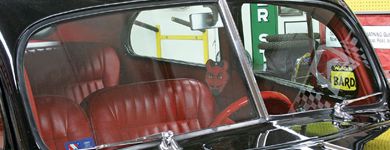
Ever since Henry's boys split the windshield in 1937, street rodders have tried numerous ways to upgrade, contemporize, or otherwise alter the front glass on post-1936 Fords. While the redesign for the 1937 year brought many changes with it, one of the more subtle changes was the peak that was added to the brow section of the roof and cowl area. While the '35-36 had a more rounded windshield area, the redesigned '37 came to a peak in the center, forcing Ford to split the windshield in half. Two separate pieces of windshield glass sat in separate gaskets, joined together at the center by a vertical gasket and division bar holding everything together. This split windshield would become a Ford staple throughout the '40s and into the '50s until replaced in 1952 by a single-piece windshield once again.
While the addition of an extra piece of shiny trim in the '40s was a welcome upgrade reminiscent of those available on the higher-end Lincolns and Mercurys, contemporary street rod design often dictates that all the stainless and chrome trim be removed for that smoothy look. There are two options popular today that remove the unsightly division bar: a one-piece windshield, and a two-piece, V-butt windshield. The problem with the one-piece windshield is the fact that the Ford bodies either need to be modified so the windshield fits the curvature or the cowl and roof, which means modifying the aforementioned peak, or suffering from an ill-fitting windshield. Therefore, the best option is to install a two-piece V-butt windshield. While the V-butt windshield design still consists of two separate windshield pieces, the gap between the two sheets of glass is minimal (the width of a credit card in some cases), resulting in nothing more than a very clean horizontal line in the center of the windshield. This design not only improves frontal vision, but also lends an aesthetic appeal when so desired.
One of the leaders in the street rod and antique auto glass field is Mike Cox at The Glasshouse in San Dimas, California. He's been cutting and installing glass in classic cars for more than 20 years and has all the expertise necessary for a top-notch job. Recently, a customer had brought in a '40 Ford sedan for Mike to install new rubber gaskets in the windshield. Time had taken its toll and the present gaskets had started to leak around the edges. The customer saw the V-butt windshield Mike had installed on another customer's car and decided to go for a more contemporary look with that design instead of the stock design. We swung by Mike's shop just as he started pulling the stock glass out and got the 411 on installing V-butt windshields.